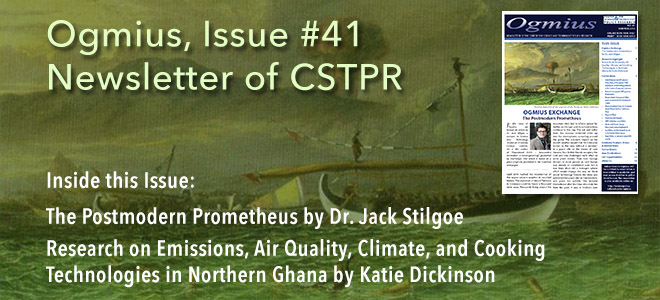Ogmius
Issue #41, Summer 2015
Ogmius Exchange
The Postmodern Prometheus by Dr. Jack Stilgoe
In this issue of Ogmius we feature an article by Dr. Jack Stilgoe, a Lecturer in Science and Technology Studies at University College London. He is the author of Experiment Earth – Responsible Innovation in Geoengineering (published by Routledge). This article is based on a piece originally published in the Guardian newspaper.
April 2015 marked the bicentennial of the largest volcanic eruption in recorded history. The explosion of Mount Tambora in Indonesia could be heard a thousand miles away. Thousands living around the mountain died, but its effects spread far further and longer, and its cultural echoes continue to this day. The ash and sulfur from the volcano stretched miles up into the stratosphere, spreading around the globe. The volcano’s impact on the world’s weather meant that 1816 became known as the ‘year without a summer’. In a grand villa on the shores of Lake Geneva, four British friends escaping the cold and rain challenged each other to write ghost stories. Their host, George (known to most people as Lord Byron) was already an established poet. But it was Mary (then still a teenager) whose effort would change the way we think about technology forever. Her story was published two years later as Frankenstein, and given the subtitle ‘The Modern Prometheus’ after the Titan who stole fire from the gods. It was, in Shelley’s own words, a story ‘on which would Speak to the mysterious fears of our nature and awaken thrilling horror’.
Lord Byron, Mary Shelley and friends had no idea that their holiday had been ruined by a volcano on the other side of the world. In the 200 years since, scientific understanding of the Earth system has explained how volcanoes can cool the planet and inspired some techno-enthusiasts to ask a Promethean question – what if we could mimic a volcano and counteract global warming?
The possibility of geoengineering or, as a report earlier this year from the National Academies relabeled it, ‘climate intervention’, began as Cold War technological hubris. In the 1960s, when global warming was first brought to the attention of the American president by his own scientific advisory committee, the presumption was that technology would be our salvation, either by shading the surface of the planet or by removing greenhouse gases. Read more …
Research Highlight
Research on Emissions, Air Quality, Climate, and Cooking Technologies
in Northern Ghana (REACCTING) by Katie Dickinson
Our Research Highlight describes a project currently underway at CSTPR led by Research Scientist Katie Dickinson. Katie is an environmental economist who studies how humans behave in the face of environmental risks. Her research topics have included sanitation behaviors in India, malaria-related decision making in Tanzania, willingness to pay for mosquito control in Wisconsin and Florida, and homeowners’ wildfire mitigation choices in Colorado.
Cooking over open fires using solid fuels like wood and charcoal is a widespread practice throughout the world. This behavior impacts local and regional air quality, global climate, and human health: household air pollution from biomass burning is estimated to contribute to four million premature deaths annually. In order to be effective and generate useful insight into potential solutions to this complex problem, cookstove intervention studies must both select cooking technologies that are appropriate for local socioeconomic conditions and cooking culture, and include comprehensive and interdisciplinary measurement strategies along a continuum of outcomes.
REACCTING (Research on Emissions, Air Quality, Climate, and Cooking Technologies in Northern Ghana) is an ongoing interdisciplinary randomized cookstove intervention study in the Kassena-Nankana Districts of Northern Ghana. The study tests two types of biomass burning stoves that were identified as having the potential to meet local cooking needs; the stoves also represent different “rungs” on the cookstove technology ladder, including an affordable and locally-made low-tech rocket stove and an imported, highly efficient gasifier stove. The 200 intervention households were randomized into four different intervention arms. In three groups, households received different combinations of two improved stoves, while the fourth group serves as a control for the duration of the two year study. (At the end of the study, these households will get to choose which stoves they would like.) Throughout the study period, ongoing measurements are made across groups at multiple steps in the causal chain linking the intervention to final outcomes of interest. These measurements assess stove use and cooking behavior, cooking emissions, household air pollution and personal exposure, health burden, and local to regional air quality. Read more …


